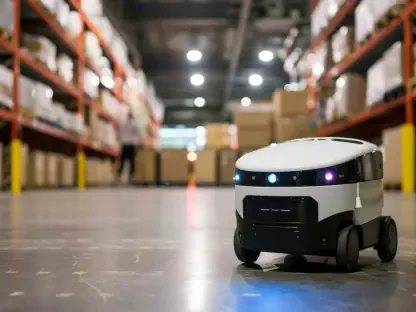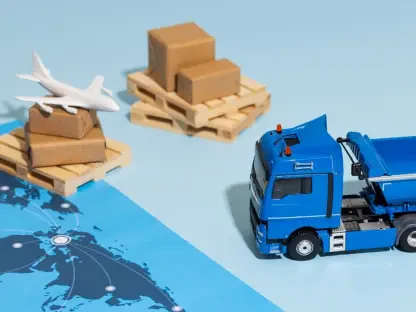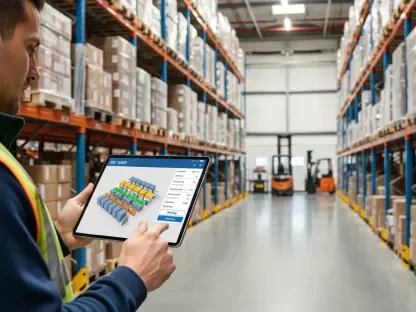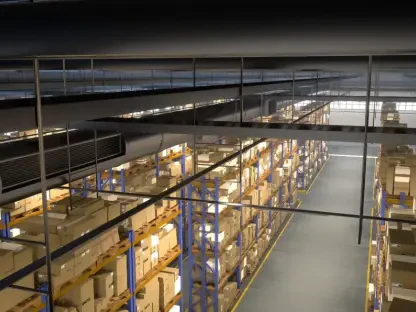In the fast-evolving world of agricultural machinery manufacturing, managing the intricate dance of production logistics is a formidable challenge, and CLAAS, a prominent player based in Harsewinkel, Germany, is meeting it head-on with innovative solutions. Known for producing combine harvesters, forage harvesters, and system tractors, the company handles a staggering volume of internal material flows daily. With market demands pushing for greater customization and complexity, CLAAS has taken a decisive step by upgrading to the latest version of the SYNCROTESS transport control system, developed by an optimization specialist from Aachen. This digital leap forward is not merely a technological update but a strategic response to ensure seamless operations at their Harsewinkel plant, where an average of 8,200 internal transports occur each day. By replacing outdated manual processes with intelligent algorithms, this upgrade promises to streamline workflows, reduce delays, and set a new standard for efficiency in the agricultural equipment sector.
Transforming Production with Digital Precision
The scale of operations at CLAAS’s Harsewinkel facility is nothing short of staggering, with thousands of internal transports moving materials across the factory floor every day to keep production lines running smoothly. The SYNCROTESS system, initially introduced nearly two decades ago and significantly enhanced in a recent update, stands as a cornerstone of this logistical feat. By integrating data from the ERP system with manual inputs, it employs sophisticated mathematical models to optimize transport orders. Forklifts, tractors, and tugger trains now follow meticulously calculated routes that minimize empty runs and ensure timely deliveries to assembly points. This technological backbone not only boosts efficiency but also addresses the growing intricacy of producing customized machinery, where every component must arrive precisely when needed to avoid costly bottlenecks in the workflow.
As agricultural equipment becomes increasingly tailored to individual customer specifications, the variety of parts and the need for smaller, more precise material deliveries have surged dramatically at CLAAS. The consolidation of two production lines into a single, centralized operation has further intensified transport demands, pushing the boundaries of what manual systems could handle. SYNCROTESS rises to this challenge by ensuring that even the most time-sensitive deliveries—some critical components must reach the assembly line within a tight 20-minute window—are managed with pinpoint accuracy. This capability is vital for maintaining the rhythm of production, especially when dealing with sequential assemblies that leave no room for error. The system’s ability to adapt to such high-pressure scenarios underscores its role as an indispensable tool in navigating the complexities of modern manufacturing logistics in the agricultural sector.
Embracing Sustainability in Logistics Operations
Efficiency is only part of the equation for CLAAS; a strong commitment to sustainability and safety shapes their approach to internal logistics as well. A notable shift has been the move away from traditional forklifts toward tugger trains, which offer enhanced speed and safety when transporting materials on rollers, significantly lowering the risk of accidents within the bustling factory environment. Additionally, a majority of the transport fleet has transitioned to electric power, a change that improves air quality and reduces noise pollution in production areas. These efforts reflect a broader dedication to creating a healthier and more sustainable workplace while maintaining the high output levels required to meet market demands.
Complementing these green initiatives, the SYNCROTESS system plays a crucial role in minimizing environmental impact by optimizing transport routes to avoid unnecessary indoor use of diesel-powered vehicles. Such transports are strategically guided outside the plant, reducing emissions and aligning with CLAAS’s overarching environmental objectives. This integration of technology with sustainable practices showcases a holistic vision where operational efficiency and ecological responsibility go hand in hand. By prioritizing both worker safety and environmental stewardship, CLAAS sets an example for the industry, demonstrating that cutting-edge logistics solutions can support not just productivity but also a commitment to a greener future in manufacturing.
Ensuring Resilience Amidst Operational Challenges
No manufacturing operation is immune to disruptions, whether due to staff shortages, unexpected delays, or supply chain hiccups, and CLAAS has fortified its resilience through the capabilities of SYNCROTESS. The system empowers dispatchers to manually prioritize urgent transport needs, ensuring that critical materials are moved swiftly to where they are needed most. Advanced algorithms automatically assign these high-priority tasks to the nearest available resource, cutting response times and maintaining the flow of production even under strain. This dynamic responsiveness is a lifeline in a high-stakes environment where every minute counts, safeguarding against potential slowdowns that could ripple through the assembly process.
Further enhancing this adaptability, the cloud-based nature of SYNCROTESS allows for seamless remote access to real-time order overviews, a feature that proves invaluable during holidays, staff substitutions, or unforeseen remote work situations. This flexibility ensures that operations continue smoothly, minimizing the risk of errors and miscommunication regardless of where team members are located. Such robust mechanisms for handling disruptions highlight how digital tools can build a buffer against the unpredictable, enabling CLAAS to uphold its commitment to timely production. The system’s design not only addresses immediate logistical needs but also prepares the company to navigate future challenges with confidence and precision.
Strengthening Operations Through Strategic Partnerships
The successful implementation of the SYNCROTESS upgrade at CLAAS is a testament to the power of collaboration with their technology partner from Aachen. During the critical go-live phase, on-site support and rapid resolution of technical issues ensured that downtime was kept to a minimum, allowing the plant to return to full capacity without significant interruption. This hands-on assistance was pivotal in smoothing the transition, demonstrating how effective vendor relationships can turn complex system overhauls into operational successes. The seamless integration of the updated software into daily workflows speaks to the meticulous planning and support that underpinned this project.
Equally impressive was the ease with which CLAAS’s internal transport department adapted to the revamped system, with 45 employees mastering the user-friendly interface after minimal training. This quick acclimatization minimized learning curves and ensured that the benefits of the upgrade were realized almost immediately on the factory floor. The partnership’s focus on practical, actionable support during implementation highlights a model for how manufacturers can adopt sophisticated technologies without disrupting production. By fostering such collaborative efforts, CLAAS has not only enhanced its logistical capabilities but also positioned itself to leverage future innovations with the same level of efficiency and success.
Reflecting on a Milestone in Logistics Innovation
Looking back, the upgrade to the SYNCROTESS system marked a pivotal moment for CLAAS, addressing the intricate demands of agricultural machinery production with a blend of digital precision and sustainable practices. The transformation tackled the immense scale of daily transports at Harsewinkel, optimized critical delivery timelines, and integrated safety and environmental considerations into core operations. Moving forward, the focus should be on continuous refinement of these systems to adapt to evolving market needs and further reduce ecological footprints. Exploring additional integrations or upgrades with emerging technologies could amplify these gains, ensuring that CLAAS remains a leader in efficient, responsible manufacturing. This milestone serves as a blueprint for the industry, suggesting that strategic investments in logistics technology, paired with strong partnerships, can pave the way for enduring operational excellence.









